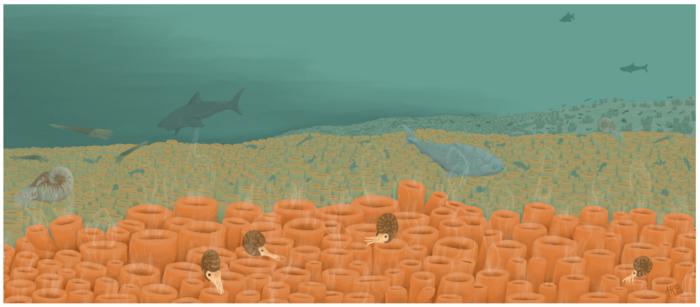In a groundbreaking discovery that reshapes our understanding of the Earth’s geological past, researchers have identified an extensive, basinwide preservation of sea sponges spanning nearly 600 kilometers across the Phosphoria glass ramp in the western United States. This remarkable fossil record, dating back approximately 300 million years to the Permian period, reveals that vast meadows of silica-rich sponges once carpeted the ancient seafloor, fundamentally influencing the geological and chemical composition of the region’s rock formations.
The Phosphoria Formation, a prominent sedimentary rock complex renowned for its phosphate deposits, has long intrigued geologists and paleontologists alike due to its rich mineral content and complex sedimentology. However, the source of its remarkable silica content remained elusive until this recent investigation. By applying advanced paleontological and geochemical techniques, the research team uncovered that the silica abundance stems substantially from the siliceous spicules—microscopic skeletal elements—of extinct sponge populations that thrived across this extensive marine landscape.
Traditional interpretations of the Phosphoria Formation primarily categorized its biogenic components as microbial or algae-based deposits. The new fossil evidence challenges these assumptions, demonstrating that the sponge communities dominated the benthic ecosystems, contributing fundamentally to the silica budget of the sediments. Detailed morphological analysis of sponge fossils preserved within this geological “glass ramp” reveals exceptional preservation processes, likely involving rapid burial and silica diagenesis, which allowed the delicate skeletal frameworks of these organisms to endure for hundreds of millions of years.
The spatial scale of this sponge preservation is unprecedented, covering a corridor approximately 600 kilometers long. Such basinwide preservation indicates a stable and hospitable marine environment during the late Paleozoic, characterized by extensive submarine plateaus conducive to sponge proliferation. The researchers hypothesize that these sponge meadows played a pivotal role in silica cycling at the basin scale, influencing sediment compaction, porosity, and ultimately contributing to the unique glassy texture observed in the Phosphoria rocks today.
Geochemically, the silica derived from siliceous sponges alters the sedimentary matrix, impacting both the mechanical strength and the diagenetic pathways within the rock complex. This biogenic contribution is crucial for reconstructing ancient biogeochemical cycles and lends insight into how marine ecosystems and sedimentary platforms co-evolved during the Permian period. Beyond its geological implications, this discovery also opens avenues for exploring how ancient biological systems influenced Earth’s material reservoirs and sediment formation processes.
The technological advancements enabling this discovery include high-resolution imaging, electron microscopy, and geochemical assays that delineate the minute details of sponge spicules and their preservation states. These tools allowed the team to differentiate sponge fossils from other siliceous marine organisms and to assess their contribution quantitatively across the basin. The integration of paleontological data with sedimentological and geochemical modeling provides a comprehensive picture of the ancient marine ecosystem’s complexity.
From an evolutionary perspective, the dominance of sponges inferred from this study provides clues about marine biodiversity and ecological succession leading up to the Permian-Triassic boundary. Sponges, among the oldest multicellular organisms, often serve as indicators of environmental stability and nutrient cycling. This research thus enhances our understanding of Paleozoic marine habitats and offers a window into the ecosystem dynamics that preceded one of Earth’s most significant mass extinction events.
Furthermore, the study underscores the importance of re-evaluating fossil assemblages with modern techniques, as previous misidentifications can obscure monumental biological and geological insights. The misdiagnosis of sponge fossils in the Phosphoria Formation highlights how advancements in paleontological methods can dramatically alter scientific interpretations, emphasizing the dynamic nature of earth sciences and the continuous evolution of our knowledge base.
The preservation quality of these sponges is not only a testament to the unique depositional environment but also to the geochemical processes that stabilized such fragile structures over geologic timeframes. The diagenetic transformation of sponge silica into amorphous or partially crystalline forms contributes to the “glass factory” moniker, shedding light on the natural variability of biogenic silica in sedimentary environments and its geological preservation potential.
In sum, this basinwide discovery of sponge preservation revolutionizes our understanding of the Phosphoria Formation’s composition and origins. It beckons the scientific community to revisit other sedimentary basins with similar geological characteristics, where overlooked biogenic components might reshape existing paradigms about Earth’s paleoenvironment and sedimentary processes. The findings not only enrich geological and biological sciences but also underscore the intricate interplay between life and the lithosphere across deep time.
This revelation invites a broader reflection on how ancient marine lifeforms, such as sponges, played hidden but crucial roles in shaping Earth’s mineral wealth and sedimentary architecture. As such, it encourages interdisciplinary research bridging paleontology, geochemistry, sedimentology, and evolutionary biology to unravel the complexities of Earth’s deep past and its ongoing geological narrative.
Subject of Research: Basinwide basin-scale preservation of siliceous sponges on the Phosphoria glass ramp during the Permian period in the western United States.
Article Title: Glass factory found: Basinwide (600 km) preservation of sponges on the Phosphoria glass ramp, Permian, USA
News Publication Date: 12-Nov-2025
Web References:
- Article URL: http://plos.io/47syMdi
- DOI: http://dx.doi.org/10.1371/journal.pone.0333211
Image Credits: A.M. Rasmussen, CC-BY 4.0 (https://creativecommons.org/licenses/by/4.0/)
Keywords: Phosphoria Formation, Paleozoic sponges, siliceous fossils, Permian marine ecosystems, sedimentary biogeochemistry, silica cycling, sponge spicules, fossil preservation, basinwide fossil record, marine paleoenvironment




